
Beadwork is the art or craft of attaching beads to one another by stringing them onto a thread or thin wire with a sewing or beading needle or sewing them to cloth. Beads are produced in a diverse range of materials, shapes, and sizes, and vary by the kind of art produced. Most often, beadwork is a form of personal adornment, but it also commonly makes up other artworks.

A bead is a small, decorative object that is formed in a variety of shapes and sizes of a material such as stone, bone, shell, glass, plastic, wood, or pearl and with a small hole for threading or stringing. Beads range in size from under 1 millimeter (0.039 in) to over 1 centimeter (0.39 in) in diameter.
Bead weaving is a set of techniques for weaving sheets and objects of seed beads. Threads are strung through and/or around the beads to hold them together. It can be done either on a loom or using one of a number of off-loom stitches.
Crochet is a process of creating textiles by using a crochet hook to interlock loops of yarn, thread, or strands of other materials. The name is derived from the French term croc, which means 'hook'. Hooks can be made from a variety of materials, such as metal, wood, bamboo, bone or even plastic. The key difference between crochet and knitting, beyond the implements used for their production, is that each stitch in crochet is completed before the next one is begun, while knitting keeps many stitches open at a time. Some variant forms of crochet, such as Tunisian crochet and broomstick lace, do keep multiple crochet stitches open at a time.

Knitting is a method for production of textile fabrics by interlacing yarn loops with loops of the same or other yarns. It is used to create many types of garments. Knitting may be done by hand or by machine.

Seed beads or rocailles are uniformly shaped, spheroidal beads ranging in size from under a millimeter to several millimeters. Seed bead is also a generic term for any small bead. Usually rounded in shape, seed beads are most commonly used for loom and off-loom bead weaving. They may be used for simple stringing, or as spacers between other beads in jewelry.
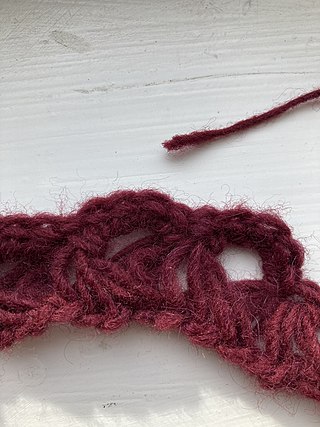
Broomstick lace, also known as jiffy lace and peacock eye crochet, is a historic crochet technique from the 19th century made using a crochet hook and another long slender item such as a knitting needle. Traditionally a broomstick was used, hence the name, but the modern variant is a lightweight plastic knitting needle or smooth wooden craft dowel. A larger knitting needle or dowel will result in a lacier effect, while a smaller will provide a more closely woven effect. The technique is used to make clothing, blankets, and other crocheted items. In most crochet techniques, each stitch is finished before beginning the next. Broomstick lace is different; like in knitting and Tunisian crochet, many stitches are left open for broomstick lace.
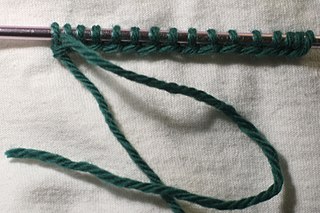
In knitting, casting on is a family of techniques for adding new stitches that do not depend on earlier stitches, i.e., having an independent lower edge. In principle, it is the opposite of binding off, but the techniques involved are generally unrelated.

Brick Stitch, also known as the Cheyenne Stitch or Comanche Stitch, is a bead weaving stitch in which individual beads are stacked horizontally in the same pattern as bricks are stacked in a wall.
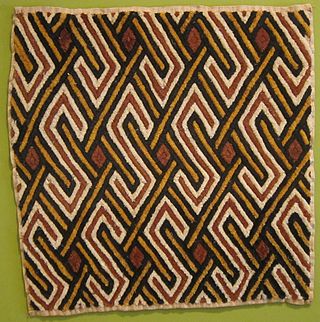
African textiles are textiles from various locations across the African continent. Across Africa, there are many distinctive styles, techniques, dyeing methods, and decorative and functional purposes. These textiles hold cultural significance and also have significance as historical documents of African design.

The blanket stitch is a stitch used to reinforce the edge of thick materials. Depending on circumstances, it may also be called a cable stitch or a crochet stitch. It is "a decorative stitch used to finish an unhemmed blanket. The stitch can be seen on both sides of the blanket."

A shell stitch is a crochet motif often used as a border around other patterns or in staggered rows to create a distinctive fabric pattern. Shell stitches take the shape of arcs and semicircles, hence the name. Shell stitches are often used as edging for crocheted items such as Afghan blankets and sweaters.
Square stitch is an off-loom bead weaving stitch that mimics the appearance of beadwork created on a loom. Loom patterns and even cross stitch embroidery patterns may be used for square stitch pieces. Because each bead in a square stitch piece is connected by thread to each of the four beads surrounding it, this stitch is very strong.

The Native American Church (NAC), also known as Peyotism and Peyote Religion, is a syncretic Native American religion that teaches a combination of traditional Native American beliefs and elements of Christianity, especially pertaining to the Ten Commandments, with sacramental use of the entheogen peyote. The religion originated in the Oklahoma Territory (1890–1907) in the late nineteenth century, after peyote was introduced to the southern Great Plains from Mexico. Today it is the most widespread indigenous religion among Native Americans in the United States, Canada, and Mexico, with an estimated 300,000 adherents.
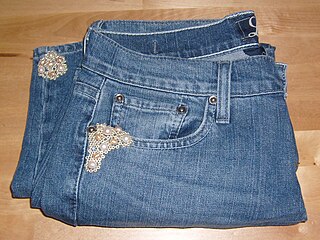
Bead embroidery is a type of beadwork that uses a needle and thread to stitch beads to a surface of fabric, suede, or leather.

Native American jewelry refers to items of personal adornment, whether for personal use, sale or as art; examples of which include necklaces, earrings, bracelets, rings and pins, as well as ketohs, wampum, and labrets, made by one of the Indigenous peoples of the United States. Native American jewelry normally reflects the cultural diversity and history of its makers, but tribal groups have often borrowed and copied designs and methods from other, neighboring tribes or nations with which they had trade, and this practice continues today. Native American tribes continue to develop distinct aesthetics rooted in their personal artistic visions and cultural traditions. Artists may create jewelry for adornment, ceremonies, and display, or for sale or trade. Lois Sherr Dubin writes, "[i]n the absence of written languages, adornment became an important element of Indian communication, conveying many levels of information." Later, jewelry and personal adornment "...signaled resistance to assimilation. It remains a major statement of tribal and individual identity."
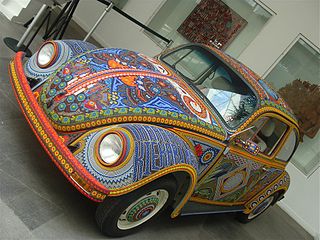
The Vochol is a Volkswagen (VW) Beetle that has been decorated with traditional Huichol (Wirrárika) beadwork from the center-west of Mexico. The name created by José Jaime Volochinsky is a combination of "vocho", a popular term for VW Beetles in Mexico, and "Huichol", the common name of the Wirrárika indigenous group. The project was sponsored by agencies associated with the Museo de Arte Popular, Mexico City, the states of Jalisco and Nayarit and other public and private organizations. The Volkswagen was covered in 2,277,000 beads applied by eight artisans from two Huichol families in an exclusive design based on Huichol culture.

Huichol art broadly groups the most traditional and most recent innovations in the folk art and handcrafts produced by the Huichol people, who live in the states of Jalisco, Durango, Zacatecas and Nayarit in Mexico. The unifying factor of the work is the colorful decoration using symbols and designs which date back centuries. The most common and commercially successful products are "yarn paintings" and objects decorated with small commercially produced beads. Yarn paintings consist of commercial yarn pressed into boards coated with wax and resin and are derived from a ceremonial tablet called a neirika. The Huichol have a long history of beading, making the beads from clay, shells, corals, seeds and more and using them to make jewelry and to decorate bowls and other items. The "modern" beadwork usually consists of masks and wood sculptures covered in small, brightly colored commercial beads fastened with wax and resin.

Tapestry crochet is sometimes called jacquard crochet, intarsia, mosaic, fair isle, and colorwork, but today these terms usually describe different techniques. Since the yarns are switched back and forth to create motifs, tapestry crochet fabric looks more like it was woven on a loom than crocheted with a hook.
Right-angle weave stitch, also known as RAW, is an off-loom bead weaving technique. Beads are stitched together with thread only making right angle turns, hence the name. The result is an almost fabric like piece of beadwork. Right-angle weave can be woven with either one needle or two. With single needle right-angle weave, the thread path moves in a figure-eight pattern. For double needle right-angle weave, the threads cross each other along the center bead of each stitch as they head in opposite directions. RAW can be formed into flat pieces, tubes, or 3 dimensional figures. There are also variations on the basic stitch like cubic right angle weave, or CRAW. Seed beads, fire polished beads and crystal beads are common choices in pieces using right-angle weave. Variations of the right-angle weave also include PRAW. CRAW is usually worked in sets of four, but in PRAW, sets can be expanded to over five.

















